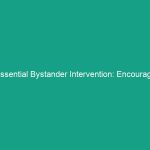Introduction
In an ever-evolving landscape of workplace Regulations and Standards, Health and Safety Compliance Audits have become a cornerstone for organizations striving to maintain a secure Environment for their employees. These audits not only ensure compliance with legal requirements but also foster a culture of Safety that can lead to increased productivity and employee morale. Understanding the significance of these audits is essential for both employers and employees, making it imperative to explore the guidelines that govern effective health and safety compliance audits.
Understanding Regulatory Frameworks
At the heart of any effective Health and Safety Compliance Audit is a thorough understanding of the regulatory frameworks that govern Workplace Safety. These regulations are designed to protect workers from Hazards and ensure that employers provide a safe working environment. The main regulatory bodies, such as the Occupational Safety and Health Administration (OSHA) in the United States, set forth guidelines that organizations must follow.
Key Regulatory Bodies
Familiarity with the key regulatory bodies is crucial. These organizations not only set standards but also provide resources for compliance:
- Occupational Safety and Health Administration (osha): This federal agency is responsible for ensuring safe and healthy working conditions by enforcing standards and providing Training, outreach, education, and assistance.
- Environmental Protection Agency (EPA): The EPA regulates hazardous waste and environmental impacts, ensuring that companies adhere to environmental laws that protect public health and the environment.
- National Institute for Occupational Safety and Health (NIOSH): NIOSH conducts research and makes recommendations for the Prevention of work-related illnesses and injuries.
Importance of Compliance
Compliance with these regulations is not merely about avoiding penalties; it is about fostering a culture of safety that can significantly reduce workplace accidents and health issues. Non-compliance can lead to severe consequences, including fines, legal action, and reputational damage. A thorough understanding of the regulations is fundamental for conducting effective Health and Safety Compliance Audits.
Best Practices for Conducting Health and Safety Compliance Audits
Implementing Best Practices during Health and Safety Compliance Audits can enhance the effectiveness of the audit process. Here are some essential practices that should be considered:
Developing a Comprehensive Audit Plan
A well-structured audit plan lays the foundation for a successful audit. This plan should define the scope, objectives, and methodology of the audit. Key elements to include are:
- Scope: Clearly outline the areas of the workplace that will be audited, including specific departments or processes.
- Objectives: Identify what the audit aims to achieve, such as assessing compliance with regulations or identifying areas for improvement.
- Methodology: Decide on the methods for collecting data, such as interviews, document reviews, and site inspections.
Training Auditors Effectively
Auditors should be well-trained and knowledgeable about both the regulatory requirements and the specific processes of the organization. Training should encompass:
- Regulatory Knowledge: Understanding relevant laws and standards is crucial for identifying compliance gaps.
- Audit Techniques: Familiarity with various audit techniques, including interviews, observations, and document reviews, enhances the audit’s effectiveness.
- Communication Skills: Effective communication is key to conducting interviews and explaining findings clearly to stakeholders.
Utilizing Checklists and Tools
Utilizing comprehensive checklists can streamline the audit process and ensure that no critical areas are overlooked. These checklists should be tailored to the specific regulations and standards applicable to your organization. Additionally, consider using software tools designed for compliance audits, which can help automate data collection and analysis.
Engaging Employees in the Audit Process
Involving employees in the audit process can lead to more accurate results and foster a culture of safety. Employees are often the first to identify potential Hazards and compliance issues. Encouraging their participation can include:
- Surveys and Feedback: Conduct anonymous surveys to gather insights from employees about safety concerns and compliance issues.
- Focus Groups: Organize focus groups to discuss safety practices and gather suggestions for improvement.
- Training Sessions: Provide training sessions on the importance of compliance and how employees can contribute to the audit process.
Documenting Findings and Recommendations
Accurate documentation of audit findings is essential for tracking compliance and implementing improvements. Reports should clearly outline:
- Findings: Detail any compliance gaps or safety issues identified during the audit.
- Recommendations: Provide actionable recommendations for addressing identified issues.
- Follow-Up Actions: Outline a plan for follow-up audits or assessments to ensure that recommendations are implemented.
Case Studies: Successful Health and Safety Compliance Audits
Examining real-world examples of successful Health and Safety Compliance Audits can provide valuable insights into Best Practices. Here are two case studies that highlight effective audit strategies:
Case Study 1: Manufacturing Plant Overhaul
A large manufacturing company faced multiple OSHA citations due to non-compliance with safety standards. To address these issues, they implemented a comprehensive audit process that included:
- Conducting a thorough self-audit using a detailed checklist based on OSHA standards.
- Engaging employees through workshops to identify potential hazards and gather feedback on safety practices.
- Developing an action plan that included immediate corrective actions and long-term safety improvements.
As a result, the company not only reduced its citation rate but also improved employee morale and productivity.
Case Study 2: Construction Site Safety Revamp
A construction firm conducted an audit after a series of accidents on its job sites. The audit revealed several compliance gaps, including inadequate training and lack of proper Safety Gear. Key actions taken included:
- Implementing mandatory safety training sessions for all employees and subcontractors.
- Establishing a safety committee that met regularly to review compliance and safety concerns.
- Investing in high-quality safety equipment and ensuring all employees were properly equipped.
The proactive measures led to a significant decrease in accidents and improved compliance with industry regulations.
Challenges in Health and Safety Compliance Audits
Despite the clear Benefits of Health and Safety Compliance Audits, organizations often face several challenges in implementing them effectively. Identifying these challenges can help organizations develop strategies to overcome them.
Resource Constraints
Many organizations struggle with limited resources, including time, personnel, and budget. Conducting thorough audits requires dedicated staff and financial investment, which may not always be available. To address this, organizations can:
- Prioritize Audits: Focus on high-risk areas first to maximize the impact of limited resources.
- Leverage Technology: Utilize audit management software to streamline the process and reduce manual effort.
- Seek External Help: Consider hiring external auditors for specialized expertise or to alleviate workload.
Employee Resistance
Employee resistance can also pose a significant barrier to effective audits. Some workers may feel threatened by audits, fearing repercussions for reporting safety concerns. To mitigate this, organizations should:
- Foster a Safety Culture: Promote an environment where safety is prioritized and employees feel empowered to speak up without fear of retaliation.
- Communicate Clearly: Explain the purpose of the audit and how it contributes to their safety and well-being.
- Incentivize Participation: Offer incentives for employees who actively participate in safety programs and audits.
Keeping Up with Changing Regulations
Regulatory requirements are constantly evolving, which can make compliance challenging. Organizations must stay informed about changes in laws and regulations to ensure ongoing compliance. Strategies to address this include:
- Regular Training: Provide ongoing training for staff to keep them updated on regulatory changes and compliance requirements.
- Subscribe to Updates: Sign up for newsletters or alerts from regulatory bodies to receive timely information about changes.
- Engage with Industry Associations: Join industry associations that provide resources and updates on compliance best practices and regulatory changes.
Future Trends in Health and Safety Compliance Audits
The landscape of Health and Safety Compliance Audits is continuously changing, influenced by technological advancements, evolving regulations, and an increased focus on worker well-being. Here are some future trends that organizations should be aware of:
Integration of Technology
Technology is poised to revolutionize the way audits are conducted. Innovations such as:
- Artificial Intelligence: AI can analyze large sets of data to identify trends and potential compliance issues more efficiently.
- Mobile Applications: Audit apps can allow real-time reporting and data collection, making the process more accessible and user-friendly.
- Wearable Technology: Devices that monitor worker health and safety can provide real-time data during audits.
Emphasis on Mental Health and Well-Being
As organizations recognize the importance of mental health, future audits will likely include evaluations of mental well-being programs and resources. Considerations may include:
- Assessing Stressors: Audits may evaluate workplace practices that contribute to employee stress and burnout.
- Access to Resources: Ensuring employees have access to mental health resources and support systems.
- Culture of Support: Fostering a supportive environment where mental health is openly discussed and prioritized.
Increased Focus on Sustainability
With growing awareness of environmental impacts, future Health and Safety Compliance Audits may incorporate sustainability assessments. This includes evaluating:
- Waste Management Practices: Ensuring compliance with waste disposal regulations and promoting recycling initiatives.
- Energy Consumption: Evaluating energy-efficient practices and encouraging the reduction of carbon footprints within operations.
- Supply Chain Sustainability: Assessing the environmental impact of suppliers and ensuring they adhere to safety and sustainability standards.
Conclusion
In conclusion, effective Health and Safety Compliance Audits are crucial for ensuring Workplace Safety, adhering to regulations, and fostering a culture of well-being. By understanding the regulatory frameworks, implementing best practices, learning from case studies, addressing challenges, and staying ahead of future trends, organizations can significantly enhance their compliance efforts. Regular audits not only protect employees but also contribute to the long-term success and reputation of the organization. Now is the time to commit to a proactive approach to health and safety compliance—because every worker deserves a safe and healthy workplace.


